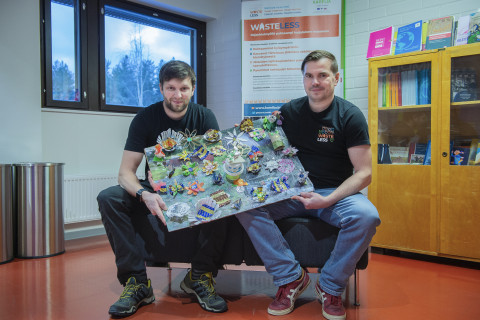North Karelia on the Finnish side of the border and the Republic of Karelia on the Russian side are dealing with very different waste management problems. In both, school children have become agents of change.
Naistenjärvi is an old industrial community in the Republic of Karelia in Russia. The closest official landfill is 32 kilometres away in Suojärvi, which means household waste often gets dumped in an illegal landfill in a nearby forest.
“Waste management in the Republic of Karelia is often very local and poorly coordinated. Many people don’t bother to take their waste to a collection point, because they know that it will just end up in the forest,” Postdoctoral Researcher Moritz Albrecht says.
Albrecht is project coordinator of the WasteLess Karelias project, which seeks to prevent littering and to improve waste management in rural villages in North Karelia and the Karelian Republic. The Russian villages participating in the project are Vieljärvi, Naistenjärvi and Tolvuja, and the Finnish villages are Timanttikylät in Juuka and Merkrijärvi in Ilomantsi
“Waste management works well in the rural villages of North Karelia. However, when it comes to recycling and people’s attitudes, there is still work ahead. Recycling stations should also be located closer to the village centres: this was an opinion shared on both sides of the border.”
In Finland, the project focuses on promoting recycling and shared collection points. In Russia, the challenges to overcome are more fundamental, as there is even a shortage of waste bins to begin with.
Waste collection points and innovative solutions
The goals of Russia’s new waste legislation are ambitious, and the country is keen to increase recycling. However, the waste management infrastructure is underdeveloped. In Vieljärvi, for example, there are only 12 collection points for mixed waste, all scattered around the village area. In Tolvuja, on the other hand, household waste is gathered on platforms that resemble those used to haul milk from farmers many decades ago. Indeed, one of the goals of the project is to set up waste collection points in the villages. The first two were opened in Naistenjärvi this autumn.
“There is a need for 10–15 waste collection points, but we can’t afford the investment,” Project Manager Gleb Yarovoy says.
Large investments in waste management are managed by private companies and, according to Yarovoy, they are not keen to invest in small rural villages. In response, the project has embarked on developing innovative solutions for, e.g., the handling of sorted plastic waste. Currently, the project aims to find out whether local entrepreneurs could transport readily sorted plastic waste to a waste management company in Petrozavodsk.
“Local entrepreneurs drive to Petrozavodsk to restock their supply on a weekly basis, and their cars are often empty on the way there. By transporting plastic waste to Petrozavodsk earning a small fee, they could also cover some of their fuel costs.”
According to Albrecht, the only possible solution in the current situation is for the people living in the villages to assume responsibility for waste management and for the transportation of sorted waste. This is where education comes in.
School children spread the word to their homes
Collaboration with schools plays an important role in the project. For instance, school children have cleaned up their home villages, learned about recycling and turned waste into art in workshops.
“For example, school children picked up 90 kilograms of litter in 1.5 hours in the Valtimo village in Finland, and 560 kilograms in Naistenjärvi, Russia,” Albrecht says.
The researchers have also conducted a survey into the attitudes of children and adolescents towards recycling and sorting. In Finland, the survey was taken by school children in Poikola school in Juuka, in Valtimo school and in the international school of Eastern Finland. In Russia, the survey was taken by school children in the participating villages.
According to the preliminary results, 20% of Russian children regarded their home village as littered or very littered, whereas the same was true for less than 10% of Finnish children. However, littering in the home village was highlighted as a problem by nearly all Finnish school children, and also by 80% of Russian children.
45% of Russian school children reported that their household waste is not sorted at all, while 45% reported that their household waste is always or sometimes sorted. In Russia, waste sorting often refers to separation and burning of paper, and occasionally to recycling of biowaste and batteries. In contrast, 80% of Finnish school children reported that their household waste is sorted.
“It is interesting that only around 15% of school children in Finland and Russia have been given household chores that involve waste sorting.”
Schools play a key role in developing waste management in the Russian villages participating the project. Eventual waste collection points should be situated close to schools, and schools would also take some responsibility for their care.
“We can teach children how to sort waste and they can bring sorted waste from their home to the collection point,” Yarovoy explains.
“Children are good at spreading the word. This is something we’ve also noticed in matters relating to energy saving,” Albrecht says.
The WasteLess Karelias project is led by the University of Eastern Finland and it has the Finnish Association for Rural Culture and Education, the Institute of Economics of the Karelian Research Centre in Petrozavodsk, and the Finnish Environment Institute as partners. The project is funded by the European Union and the Finnish and Russian governments.
Website of the WasteLess Karelias project

